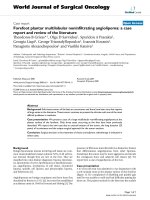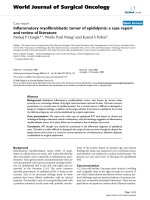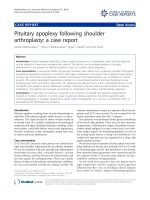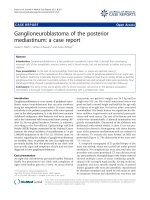Báo cáo y học: "Atrial and placental melanoma metastasis: a case report and literature review" pot
Bạn đang xem bản rút gọn của tài liệu. Xem và tải ngay bản đầy đủ của tài liệu tại đây (481.01 KB, 4 trang )
BioMed Central
Page 1 of 4
(page number not for citation purposes)
Journal of Medical Case Reports
Open Access
Case report
Atrial and placental melanoma metastasis: a case report and
literature review
Pradeep Lakshminarayana*
1
, Sarah Danson
1
, Kim Suvarna
2
and
Barry Hancock
1
Address:
1
Department of Clinical Oncology, Weston Park Hospital, Whitham Road, Sheffield, S10 2SJ, UK and
2
Department of Histopathology,
Northern General Hospital, Herries Road, Sheffield, S5 7AU, UK
Email: Pradeep Lakshminarayana* - ; Sarah Danson - ;
Kim Suvarna - ; Barry Hancock -
* Corresponding author
Abstract
Malignant melanoma can metastasize to virtually any organ of the body. The aggressiveness is
determined by the primary site, depth of dermal invasion, presence or absence of ulceration,
lymphovascular infiltration and regional lymph node involvement. We report a case of a pregnant
woman with a previous history of stage 3 melanoma who presented with cardiac metastasis and
placental melanoma infiltration. A review of literature on cardiac and placental involvement of
melanoma is also provided.
Background
Malignant melanoma is considered to be a highly aggres-
sive cancer. Post mortem studies have shown that
melanoma can metastasize to any organ of the body, with
50% of the patients found to have cardiac involvement
[1]. However only 2% of patients with metastatic
melanoma to the heart are diagnosed antemortem [2], as
most patients do not have any cardiac symptoms.
Melanoma is also unique in that it is the most common
cancer to metastasize to the placenta [3].
We report a pregnant woman with invasive melanoma
who presented with metastasis in the right atrium and pla-
cental melanoma infiltration. The balance of surgery,
chemotherapy and obstetric management in this case is
challenging.
Case report
A 32 year old woman, initially presented at the age of 27
with stage 3 malignant melanoma. The patient underwent
wide local excision of a 1.76 mm Breslow thickness
melanoma from the right thigh and shortly afterwards
was found to have a mass in the right groin. She under-
went right inguinal block dissection, with 2 of 6 lymph
nodes positive for melanoma. CT scan showed no evi-
dence of other disease sites. The patient had adjuvant high
dose interferon (20 MU/m
2
/d IV 5 days/wk × 4 weeks fol-
lowed by 10 MU/m
2
SC thrice weekly × 48 weeks) which
was discontinued after nearly 7 months due to persistent
neutropenia.
When aged 31 and 19 weeks pregnant, the patient noticed
a mass beneath her jaw consistent with right submandib-
ular lymph gland enlargement and had exertional dyps-
noea. A CT scan revealed a pericardial effusion of 1 cm
depth. A transthoracic echocardiogram showed a right
Published: 14 May 2007
Journal of Medical Case Reports 2007, 1:21 doi:10.1186/1752-1947-1-21
Received: 7 April 2007
Accepted: 14 May 2007
This article is available from: />© 2007 Lakshminarayana et al; licensee BioMed Central Ltd.
This is an Open Access article distributed under the terms of the Creative Commons Attribution License ( />),
which permits unrestricted use, distribution, and reproduction in any medium, provided the original work is properly cited.
Journal of Medical Case Reports 2007, 1:21 />Page 2 of 4
(page number not for citation purposes)
atrial mass prolapsing through the tricuspid valve with
good preservation of ventricular function.
An MRI scan of the heart confirmed the mass to be more
extensive measuring 8 cm in size and extending into the
superior vena cava (fig 1). An echocardiogram guided
biopsy of the mass (fig 2A) revealed necrotic tumour with
associated thrombus and adjacent normal myocardium.
The viable tumour was composed of moderately pleomor-
phic epitheliod melanocyes (S100/HMB45 positive) with
enlarged pleomorphic nuclei and prominent nucleoli.
The patient was keen to continue with pregnancy and after
careful consideration was commenced on palliative chem-
otherapy with dacarbazine (800 mg/m
2
IV every 3 weeks).
The decision was to deliver the baby early by elective Cae-
sarean section at 34 weeks of gestation considering the
risk of sudden cardiac death of the mother, which would
likely be associated with fetal demise. After 2 cycles of
dacarbazine, an echocardiogram showed that the atrial
mass was smaller.
However an emergency Caesarean section was performed
at 31 weeks gestation because of ante-partum haemor-
rhage. The baby delivered weighed 1.5 kg with no signifi-
cant problems in the neonatal period. Histological
examination of the placental tissue showed unremarkable
cord and membranes. The placental bed showed an early
third trimester architecture with good villous develop-
ment. Focally there were groups of viable epitheliod
melanocytes, similar to the cardiac tissues with associated
thrombus (fig 2B). Immunohistochemistry revealed
S100, HMB45 and melan A positivity, consistent with
melanoma. As there had been a response on the echocar-
diogram, we decided to proceed to 8 cycles of dacarbazine
chemotherapy. Following this, an MRI scan of the heart
showed less tumour bulk with a maximum dimension of
less than 2 × 3 cm. Clinically the patient had no dyspnoea
on exertion. The right mandibular lymph gland enlarge-
ment was persistent and a selective neck dissection was
done. This showed central degeneration in one lymph
node with a peripheral rim of fibroconnective tissue
showing melanin deposition, representing a response to
chemotherapy.
Despite the metastatic nature of her disease, this patient
remains well and is currently awaiting opinion for cardiac
HistopathologyFigure 2
Histopathology: A. Endomyocardial biopsy showed pleo-
morphic malignant melanoma(mm) with associated necrosis
(original magnification × 200). B. Placental tissue shows vil-
lous tissue(v) with foci of malignant melanoma(mm) (original
magnification × 200).
MRI of the heart showing low signal density in the right atrial (arrowed) representing metastasisFigure 1
MRI of the heart showing low signal density in the right atrial
(arrowed) representing metastasis.
Journal of Medical Case Reports 2007, 1:21 />Page 3 of 4
(page number not for citation purposes)
surgery. Her baby is now 10 months old and is free of dis-
ease.
Discussion
Metastatic melanoma of the heart is generally a part of
widespread tumour dissemination. The surgical manage-
ment of these patients varies depending on presence or
absence of extracardiac involvement and also the extent of
the cardiac tumour. If anatomically feasible, complete
resection with reconstruction should be attempted [4].
Indications for complete surgical resection are patients
with a preoperative Karnofsky performance status of more
than 80%, minimal extracardiac disease, or a deteriorating
clinical picture due to cardiac symptoms [4]. In extensive
disease, surgical debulking may be considered as a pallia-
tive therapeutic option.
Chemotherapy was considered to be the best available
option of treatment in this case, considering the risk of a
major surgical procedure on the viability of the fetus.
There are some previously published reports of the use of
chemotherapy for metastatic melanoma in pregnancy.
Harkin et al. reported the use of dacarbazine in the 3
rd
tri-
mester which induced dramatic remission [5]. Another
report suggested that combination chemotherapy which
included dacarbazine when used in the 2
nd
trimester did
not interfere with the maturation and delivery of the
infant [6]. No congenital anomalies in infants born to
women treated with dacarbazine have been reported after
treatment during the 2
nd
or 3
rd
trimester.
Sorafenib an oral targeted agent and a multi-kinase inhib-
itor, is well tolerated but has little or no anti tumour activ-
ity when used alone in advanced melanoma [7]. Ongoing
trials in advanced melanoma are evaluating sorafenib in
combination therapies. However this agent has not been
studied in pregnant women and is not recommended for
use in pregnancy.
Placental and fetal metastasis related to cancers have been
documented before, the most common being melanoma
[8]. The risk of development of melanoma in the fetus
with placental involvement is approximately 22%. Babies
born with placental metastasis should therefore be con-
sidered high risk and monitored closely. Infants develop-
ing clinical evidence of maternally derived metastasis
have poor prognosis with mortality reaching 100% and
death typically occurring within 3 months of diagnosis
[8].
Some difficult ethical issues arise from this case. Firstly,
because of poor median survival of 6 months in pregnant
women with metastatic melanoma which may make them
seriously ill before term, putting the life of the fetus at risk
[9]. However, recent reports suggest that there is no signif-
icant difference in outcome and survival rate between
pregnant and non-pregnant women with melanoma [10].
Secondly, there is an increased risk of melanoma in the
infant and when found the prognosis is invariably poor.
Maternal factors associated with an unfavourable infant
prognosis include maternal age less than 30 years, primi-
parity, disease onset more than 3 years before current
pregnancy, nodal metastasis before pregnancy, more than
three sites of metastatic foci during the third trimester, pri-
mary site of the leg, and maternal death within 1 month
of birth [3]. Counselling of pregnant women who develop
metastatic melanoma is vital. The patient and carers need
support in their decisions about whether to continue with
pregnancy and which treatment options to pursue.
Conclusion
Metastatic melanoma can sometimes be associated with a
good outcome as illustrated in this case. Chemotherapy is
a reasonable alternative to surgery when used for disease
control in an obstetric setting. A multidisciplinary team
approach is vital in management of these complex cases.
Competing interests
The author(s) declare that they have no competing inter-
ests.
Authors' contributions
PL is primarily responsible for drafting, literature search,
submission and revision of the manuscript. SD and BH
are responsible for manuscript editing and advice on liter-
ature review. KS is responsible for writing up pathology,
providing the slides and manuscript editing. All authors
have read and approved the final manuscript.
Acknowledgements
The patient has kindly consented for the case report to be published.
References
1. Klatt EC, Heitz DR: Cardiac metastasis. Cancer 1990,
65:1456-1459.
2. Savoia P, Fierro MT, Zaccagna A, Bernengo MG: Metastatic
melanoma of the heart. J Surg Oncol 2000, 75:203-207.
3. Baergen RN, Johnson D, Moore T, Benirschke K: Maternal
melanoma metastatic to the placenta: a case report and
review of literature. Arch Pathol Lab Med 1997, 121:508-511.
4. Manner G, Harting MT, Russo P, Gregoric ID, Mukhopadhyay M,
Flamm SD, Frazier OH: Surgical management of metastatic
melanoma to the ventricle. Tex Heart Inst J 2003, 30:218-220.
5. Beyeler M, Hafner J, Beinder E, Fauchere JC, Stoeckli SJ, Fehr M, Dum-
mer K: Special considerations for stage IV melanoma during
pregnancy. Arch Dermatol 2005, 141:1077-1079.
6. Dipaola KS, Goodin S, Ratzell M, Florczyk M, Karp G, Ravikumar TS:
Chemotherapy for metastatic melanoma during pregnancy.
Gynecol Oncol 1997, 66:526-530.
7. Eisen T, Ahmad T, Flaherty KT, Gore M, Kaye S, Marais R, Gibbens I,
Hackett S, James M, Schuchter LM: Sorafenib in advanced
melanoma: a Phase II randomised discontinuation trial anal-
ysis. Br J Cancer 2006, 95:581-586.
8. Alexander A, Samlowski WE, Grossman D, Bruggers CS, Harris RM,
Zone JJ, Noyes RD, Bowen GM, Leachman SA: Metastatic
melanoma in pregnancy: risk of transplacental metastases in
the infant. J Clin Oncol 2003, 21:2179-2186.
Publish with BioMed Central and every
scientist can read your work free of charge
"BioMed Central will be the most significant development for
disseminating the results of biomedical research in our lifetime."
Sir Paul Nurse, Cancer Research UK
Your research papers will be:
available free of charge to the entire biomedical community
peer reviewed and published immediately upon acceptance
cited in PubMed and archived on PubMed Central
yours — you keep the copyright
Submit your manuscript here:
/>BioMedcentral
Journal of Medical Case Reports 2007, 1:21 />Page 4 of 4
(page number not for citation purposes)
9. Johnston SR, Broadley K, Henson G, Fisher C, Henk M, Gore ME:
Management of metastatic melanoma during pregnancy.
BMJ 1998, 316:848-849.
10. Silipo V, Simone P, Mariani G, Buccini P, Ferrari A, Catricala C: Malig-
nant melanoma and pregnancy. Melanoma Res 2006,
16:497-500.









